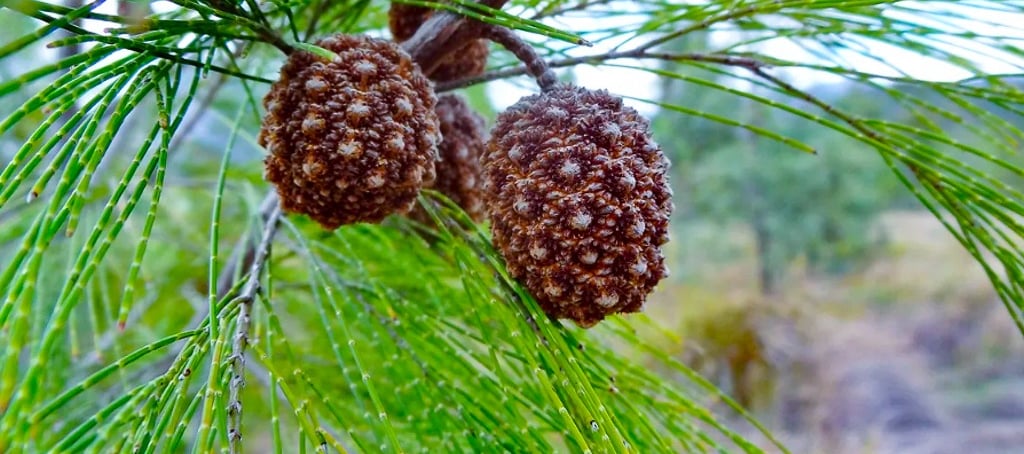Dioecious and Monoecious Reproduction


Recently, someone asked me why their sheoak tree has spikey cones while their friend's tree doesn't. Also, how can you tell the difference when choosing a tree for planting? It's a curious question that delves into the intriguing world of plant reproduction, specifically the concepts of dioecious and monoecious strategies.
Plants, just like animals, have fascinating ways of reproducing. Plants employ two key strategies: dioecious and monoecious reproduction. Understanding these strategies enhances our knowledge of plant biology and aids in conservation efforts and agricultural practices.
Allocasuarina, also known as sheoaks, are a genus of trees and shrubs native to Australia and Southeast Asia that exhibit dioecious characteristics. Male Allocasuarina trees produce cone-like structures that release pollen, while female trees produce small flowers that develop into woody fruiting structures containing seeds.
Other examples of dioecious plants include:
Eucalypts (Eucalyptus spp.): Eucalyptus trees are dioecious, with male and female flowers typically found on separate trees. Male flowers produce pollen, while female flowers develop into woody seed capsules.
Paw Paws (Carica papaya): Paw Paw trees are dioecious, with male and female flowers on separate plants. Male flowers have long stamens with pollen, while female flowers have ovary structures that develop into fruits.
Kangaroo Paw (Anigozanthos spp.): Kangaroo Paw plants are dioecious, with separate male and female plants. Male flowers produce pollen, while female flowers develop into seed capsules.
Monoecious plants have male and female reproductive structures on the same individual plant. For instance, tomatoes (Solanum lycopersicum) are a well-known monoecious plant. Tomatoes have flowers with both male and female parts on the same plant, allowing for self-pollination or pollination by insects.
Some more examples of monoecious plants include:
Everlasting Daisies (Xerochrysum spp.): Everlasting Daisies are monoecious plants with separate male and female flowers on the same plant. They are capable of self-pollination but can also be pollinated by insects.
Verticordia (Verticordia spp.): Verticordia plants are monoecious, with flowers containing both male and female reproductive parts. They rely on pollinators like bees for efficient pollination.
Eremophilas (Eremophila spp.): Eremophilas are monoecious shrubs or small trees with flowers and both male and female structures. They attract pollinators such as birds and bees for pollination.
Allocasuarina and pine cones represent distinct evolutionary adaptations shaped by their respective tree lineages, ecological niches, reproductive strategies, and survival mechanisms. Studying these evolutionary aspects enhances our understanding of plant diversity, adaptation, and ecosystem dynamics over evolutionary time scales.
Paleontologists have discovered fossilised remains of Allocasuarina trees, including cone-like structures, but these findings are relatively rare compared to other plant fossils. Fossilised Allocasuarina cones provide valuable insights into these trees' evolutionary history and ecological adaptations over millions of years.
The fossil record of Allocasuarina cones helps researchers understand the morphology, reproductive strategies, and distribution of ancient Allocasuarina species. By studying fossilised cones, paleontologists can infer aspects such as seed dispersal mechanisms, environmental conditions, and interactions with other organisms in prehistoric ecosystems.
While Allocasuarina cones may not be as commonly found as other plant fossils like ferns or coniferous leaves, their discovery contributes to our broader understanding of plant evolution and biodiversity through geological time. As fossilisation requires specific conditions for preservation, finding well-preserved Allocasuarina cones adds valuable pieces to the Earth's ancient flora puzzle.
How to Differentiate Between Dioecious and Monoecious Plants
Flower Structure: Dioecious plants have distinct male and female flowers on separate plants, whereas monoecious plants have both flowers on the same plant.
Reproductive Organs: In dioecious plants, you'll find either male or female reproductive organs (e.g., stamens or pistils) exclusively on each plant, while in monoecious plants, both types of organs are present on the same plant.
Fruit Production: Dioecious plants often require cross-pollination between male and female plants to produce fruit and seeds, whereas monoecious plants can self-pollinate or rely on wind or insects for pollination.
Allocasuarina trees typically begin to produce cones and flowers when they reach maturity, which can vary depending on the species and environmental conditions. Allocasuarina trees become sexually mature and start flowering between 5 and 10 years old, although some species may take longer to reach this stage.
When propagating Allocasuarinas from cuttings, the resulting plants will typically have the same sex as the parent plant. For example, if you take a cutting from a female Allocasuarina tree, the resulting propagated plant will also be female. Likewise, if you take a cutting from a male tree, the propagated plant will be male. This is because the sex of Allocasuarina trees is determined by their chromosomes, and this genetic information is passed down to the new plants through cuttings.
When growing Allocasuarinas from seeds, as we do here at Ironstone, the resulting plants can be either male or female, and their sex is not determined until they mature and start flowering.
Having a mix of dioecious and monoecious plants can be beneficial for several reasons. Dioecious plants promote genetic diversity through cross-pollination between male and female individuals, leading to healthier populations with increased adaptability to environmental changes.
Mixing dioecious and monoecious crops can improve yields by ensuring adequate pollination and fruit/seed production. Understanding the differences between these reproductive strategies is important for plant enthusiasts, farmers, conservationists, and researchers alike.
